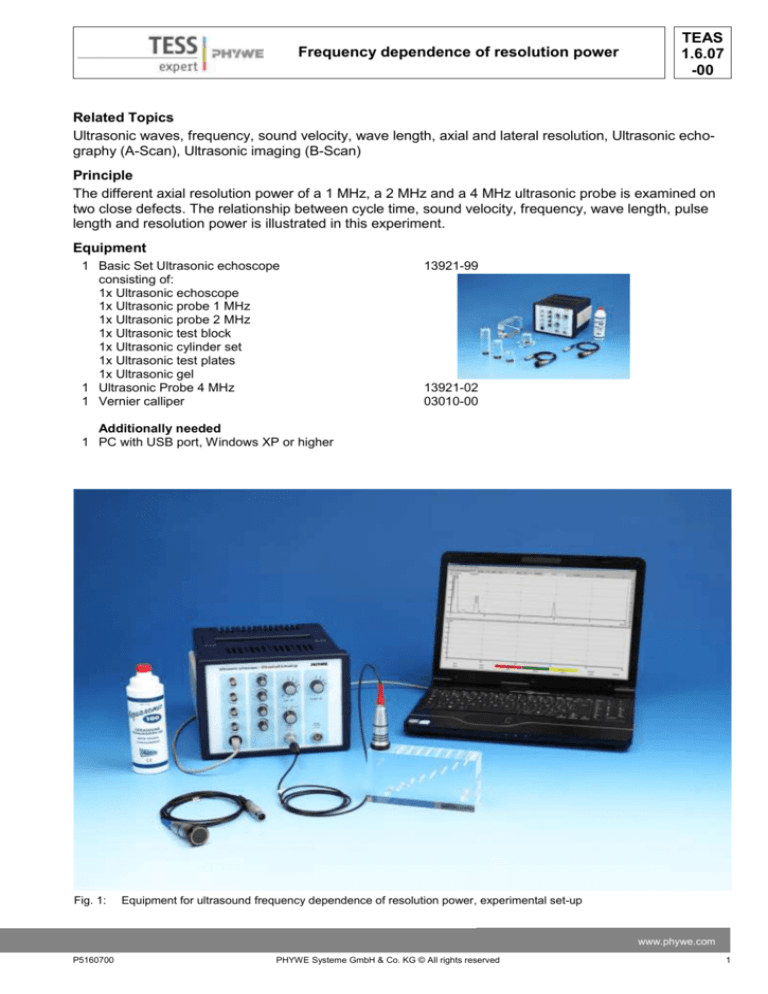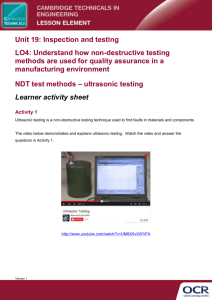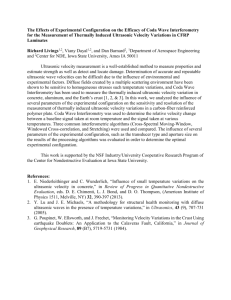
Frequency dependence of resolution power
TEAS
1.6.07
-00
Related Topics
Ultrasonic waves, frequency, sound velocity, wave length, axial and lateral resolution, Ultrasonic echography (A-Scan), Ultrasonic imaging (B-Scan)
Principle
The different axial resolution power of a 1 MHz, a 2 MHz and a 4 MHz ultrasonic probe is examined on
two close defects. The relationship between cycle time, sound velocity, frequency, wave length, pulse
length and resolution power is illustrated in this experiment.
Equipment
1 Basic Set Ultrasonic echoscope
consisting of:
1x Ultrasonic echoscope
1x Ultrasonic probe 1 MHz
1x Ultrasonic probe 2 MHz
1x Ultrasonic test block
1x Ultrasonic cylinder set
1x Ultrasonic test plates
1x Ultrasonic gel
1 Ultrasonic Probe 4 MHz
1 Vernier calliper
13921-99
13921-02
03010-00
Additionally needed
1 PC with USB port, Windows XP or higher
Fig. 1:
Equipment for ultrasound frequency dependence of resolution power, experimental set-up
www.phywe.com
P5160700
PHYWE Systeme GmbH & Co. KG © All rights reserved
1
TEAS
1.6.07
-00
Frequency dependence of resolution power
Caution!
Pay attention to the special operation and safety instructions in the manual of ultrasonic echoscope.
Tasks
1. Measure the block in the three dimensions using the calliper.
2. Record the echo of the background in these directions and calculate the sound velocity.
3. Measure the period of the ultrasonic wave on the different ultrasonic probes. Calculate the frequence. Based on the sound velocity, calculate the wave length.
4. Measure the width of an ultrasonic alternation (half-wave). Measure the width of a wave at 50 % of
the maximum elongation (maximum of the sinus curve). The result is called the pulse-width. Repeat
it for the other probes.
5. Measure the time of flight to the holes 1 and 2 (i.e. the two small holes right next to each other) with
every single probe. Take two readings, one at the beginning of the echo, and the other one at its
maximum. Based on these two figures, calculate the distance between the two holes and compare
the results.
Set-up and Procedure
According to task 1: measure the block in the three dimensions, using the calliper. Apply only gentle
pressure to avoid scratches. The block is soft in comparison to the calliper.
.
Prepare the echoscope (read manual of echoscope, especially from sections 4 to the a-scan, 5.5.1)
Connect the echoscope to the PC
Connect the 1 MHz probe to the “Probe (Reflexion)” plug
Switch the selection knob to “Reflexion”
Couple a probe to the test bloc using a gel or a water film
When using water as couplant make sure it does not run under the cylinder. It could produce ghost
echoes.
The measure Ultra Echo software shows the reflected wave as a peak. Adjust the transmitter and
receiver amplifier settings until the peak height maximum covers at least 75% of the window height.
The peak shape can be optimised adjusting the time-TGC (Time Gain Control) parameters.
According to task 2: Measure the time of flight for the ground echo in the three dimensions. For the
longest side, switch the measuring range (in the software) from. „Half“ to „Full“. The time of flight of
the echo is longer than 100 micro seconds.
Measure the time of flight at the bottom of the rising echo peak edge (Fig.: 2). Time of flight
measurements at peak maximum can lead to wrong results. The peak shape can be influenced by
probe frequency and damping of the ultrasonic signal.
2
PHYWE Systeme GmbH & Co. KG © All rights reserved
P5160700
Frequency dependence of resolution power
Fig. 3:
-
TEAS
1.6.07
-00
Measurement of a periodical cycle (4 MHz)
The time of flight can be read out directly using the software cursors. The red and green vertical
lines can be moved with the cursor. Automatically, the position of the lines is mentioned under the
red and green bar under the diagram at the bottom.
Fig. 2:
Measurement of the time of flight of the back wall echo.
www.phywe.com
P5160700
PHYWE Systeme GmbH & Co. KG © All rights reserved
3
TEAS
1.6.07
-00
-
-
-
-
-
-
Calculate the ultrasound velocity
Switch the software to the HF-mode. Use the possibilities to spread the the diagram to read it
properly. (f.e. in fig.4)
According to task 3: Measure the frequency. With these settings, it is the duration of a periodical
cycle. Place one cursor at the beginning of a frequency cycle and the other one at the end. The
difference gives the time. Multiply by the frequency with the time to derive a length. That yields a
measure of the capability (the resolution power) of the probe to perform a certain task.
Repeat the procedure for the other ultrasonic probes (2 and 4 MHz).
Reconnect the 1 Mhz probe again. Measure directly on the two small discontinuities (holes).
With this probe, investigate one of the holes in the mddle of the block. Measure the echo in terms of
its pulse-width. For better results, use the zoom-function, illustrated in fig. 4.
repeat the procedure for probe 2 and 4 Mhz.
Reconnect the 1 MHz probe
Take a reading directly over the double hole, i.e. hole 1 and 2. The nearest position you can reach is
from the side of the block. Measure the distance between the echoes at the beginning of the peak
and at the maximum. (Fig.: 4).
Repeat the measurement with the 2 and 4 Mhz probe.
Fig. 5:
4
Frequency dependence of resolution power
Illustration of the ultraechos, reflected at the two holes, close to each other. The probes with higher frequency yield
more detailed pictures. In the upper pictures, the readings are taken at the beginning of the reflection. In the pictures
at the bottom, the cursor is placed at the peak maxima of the reflections.
PHYWE Systeme GmbH & Co. KG © All rights reserved
P5160700
Frequency dependence of resolution power
Fig. 4:
TEAS
1.6.07
-00
Measurement of the pulse-width (4 MHz)
Software
The measure Ultra Echo software records, displays and evaluates the data transferred from the echoscope. After starting the program the measure mode is active and the main screen “A-Scan mode” is
open. All actions and evaluations can be selected and started in this window.
The main screen shows in the upper part the A-scan signal, the frequency of the connected transducer
and the mode (reflection/ transmission). Actual positions of cursors (red and green line) are displayed at
the bottom of the window. The cursors can be positioned by mouse click. The time of flight is displayed
under the cursor buttons.
Note
The ultrasonic test bloc and the probes should be cleaned immediately after use with water or a normal
detergent. Dried residues of ultrasonic gel are hard to remove. If necessary use a soft brush. Never use
alcohol or liquids with solvents to clean the cylinders or the probes. Deep surface scratches influence the
coupling and can induce measurement errors.
Theory and Evaluation
The ultrasound echography (also sonography) developed to be one of the most important investigation
methods among others in medicine and NDT (non destructive testing). There are unreviewable multitudes of ultrasonic devices for different applications. They all work on the same basic principles of emitting a mechanical wave, whose reflection will be recorded in an echogram.
A short mechanical wave will be produced by a short voltage pulse applied to a piezoelectric ceramic. If
this wave is coupled into solid state material it propagates in a linear way and will be reflected on interfaces with acoustic impedance changes (boundaries).
From the known distance (s), between the ultrasonic probe and the boundary of a solid, and the measured time of flight (t), the sound velocity (c) can be determined for perpendicular sound incidence, in the
following way:
www.phywe.com
P5160700
PHYWE Systeme GmbH & Co. KG © All rights reserved
5
TEAS
1.6.07
-00
Frequency dependence of resolution power
c
In reflection mode (1)
2s
t
Nearly all ultrasonic probes are covered with a protective layer on the active surface (ceramics). The
time needed by the ultrasound waves to pass through this layer is added to the time of flight measured
for the sample. This additional time causes errors in sound velocity measurements. The measured time
of flight (t) is built up from the time of flight through the protective layer (t 2L) and the time of flight through
the sample (t2s).
This error can be eliminated if the velocity of sound (c) is determined from two measurements (t1 and t2)
of different sample lengths s1 and s2:
(2) c
2 s1 s2
2 s1 s2
2
t 2*S1 t 2*L t 2*S 2 t 2*L
t1 t 2
c
2 s1 s 2
t 2*S1 t 2*S 2
Die Frequenz der Schallwelle (f) ist dabei mit der Periodendauer (T), der Wellenlänge () und der
Schallgeschwindigkeit (c) über folgende Beziehung verknüpft:
f
(3)
1
T
c
The ultrasonic investigation methods are based on the exact correlation between the investigated sample position, and volume and the recorded time of flight and probe position. The smallest distance between two points whose echoes can be just resolved is called the resolution power. The length of the
sound pulse limits the axial resolution whereas the lateral resolution power is limited by the geometry of
the sound field of the probe. Both effects strongly depends on probe frequency. With increasing frequency the sound pulses become shorter so that the axial resolution power increases. However the depth of
penetration decreases with increasing frequency.
Results
The calculation of the sound velocity is based on the length of the block and the time of flight in the
block. The length is measured with the calliper and the time of flight with the echoscope. The measurements of the time of flight relates to the length of that block in the direction.
Table 1: Measurement of the length of the block in the three dimensions and the corresponding time of
flight.
6
Lenght
Time of flight
[mm]
[µs]
width 1
40.25
29.9
width 2
79.75
58.5
width 3
149.20
108.6
PHYWE Systeme GmbH & Co. KG © All rights reserved
P5160700
Frequency dependence of resolution power
TEAS
1.6.07
-00
The sound velocity is derived from the upper table and equation (2):
aution: The sound velocity may vary according to the production process or manufacturer. (Values in the
literatur 2600-2800 m/s)
Table 2: Calculation of sound velocity using formula (2) :
C s1 / mm
t1
s2
t2
c
40,20
79,75
149,20
[µs]
29,9
58,5
108,6
[mm]
79,75
149,20
40,25
[µs]
58,5
108,6
29,9
Mean value
[m/s]
2766
2772
2769
2769
Based on the pulse-width and the periodical cycle, the nominal value of the frequency and the dependency of the pulse-width can be calculated.
Table 3: Measurements of the pulse-width and the full periodical cycle using the echoscope :
1 MHz
2 MHz
4 MHz
Period
[µs]
1,0
0,5
0,2
pulse-width
[µs]
1,8
0,9
0,5
Based on the duration of the perio and, according to equation (3), the frequency is calculated The mean
diameter of the sound velocity is divided by the frequency to yield the wave-length. There is no diversion
of longitudinal waves in acrylic material. Hence, the calculated sound velocity applies to all the frequencies of the probes.
Table 4: Charakteristics of the ultrasonic probes
1 MHz
Frequency of the
probe
2 MHz
4 MHz
period
[µs]
1,0
0,5
0,2
calculated frequency
[MHz]
1,0
2,0
5,0
wave length
[mm]
2,77
1,38
0,55
pulsbreite
[mm]
4,98
2,49
1,38
1,80
1,80
2,50
Pulse-width / wave
length
The resolution power of the time of flight method of the echoscope is 0.1 µs. For this reason, the frequency of the 4 Mhz probe cannot be specified further. (nominal duration of a cycle: 0.25 mus.). For The
ratio of the pulse-width and wave length gives approximately 2. The deviation (error) for the 4 Mhz probe
is due to error in the calculation. For this reason, the resolution power in the direction of propagation (axial) is proportional to the frequency or reciprocal (inverse proportional) to the wave length.
The distances at the double-discontinuity are calculated based on the difference of the time-of flight using the echoscope and the mean value of the velocity of sound.
www.phywe.com
P5160700
PHYWE Systeme GmbH & Co. KG © All rights reserved
7
TEAS
1.6.07
-00
Frequency dependence of resolution power
Table 5: Comparison between measured and calculated values
1 MHz
2 MHz
4 MHz
I Frequency of the
probes
Maximum (measured)
[µs]
1,3
1,3
1,3
Beginning (measured)
[µs]
2,4
1,6
1,3
Maximum (calculated)
[mm]
1,80
1,80
1,80
Beginning (calculated)
[mm]
3,32
2,22
1,80
In comparison, the distance between the 2 holes, measured with the calliper is 1,7 mm.
Only the 4 Mhz-probe is capable for a clear distinction of the 2 holes (distance maximum = distance
begin of the echo) Using materials with higher values in attenuation (damping) or higher diameter to distance ratio of two holes, would lead to wrong results. Also, Under these circumstances, taking the maxima of the echoes would not give reliable data.
Fig. 6, technical drawing with location and size of the drilled holes
8
PHYWE Systeme GmbH & Co. KG © All rights reserved
P5160700







